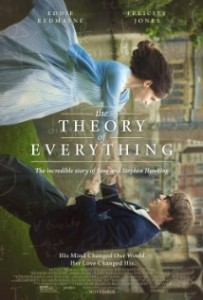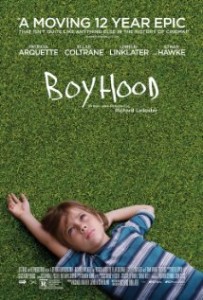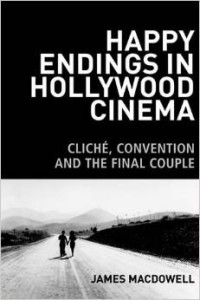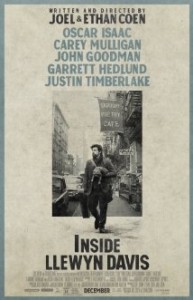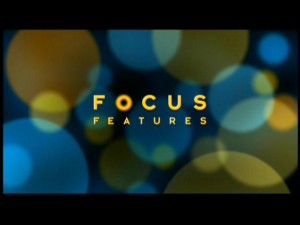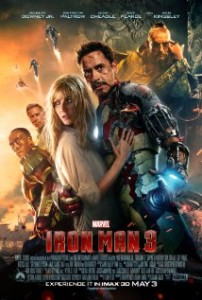An odd mixture of elements, it might seem, but something I wanted to comment on in passing in Inside Llewyn Davis evolved somewhat after a viewing last night of White House Down. Comparing such films might seem a little spurious, given how obviously different they are, but the latter helped for me to underline one of the distinctively indie features of the former.
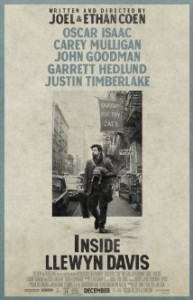
What I really liked about the new Coen brothers film – and what marks it as distinctly non-mainstream – was its refusal at any stage to turn ‘feel-good’, or even to activate some conventional narrative expectations in relatively small details along the way. A characteristic example of the latter comes when Llewyn is on his way back to New York after a dismal trip to Chicago. Picked up hitchhiking, he’s driving through the night while the owner of his ride sleeps. Out of the window we see a sign for Akron, Ohio, which has been established much earlier as the home of the child from which he has become estranged. We’re encouraged, by classical convention, to expect that he will turn off the highway in that direction – maybe causing some amusing dissent from the occupant of the passenger seat, assuming that he will awake on arrival. But no. The expectation having been triggered, the film simply ignores it and moves on (as well as being a pleasing resistance of the obvious, for those who like such things, this might also be taken as one of many indicators of the character of Llewyn, one of his many seemingly less selfish roads not taken).
In Ibsen terms – from his advice on the construction of the classically structured ‘well-made play’ in Hedda Gabler – the gun is left firmly on the wall (as opposed to the guidance that, ‘if in Act I you have a pistol on the wall, then it must fire in the last act’). Nothing quite so dramatic as a gun appears in Inside Llewyn Davis, of course, but the same principle applies. Some devices activated earlier in the film are sustained later (the cat/s, to at least some extent, although this is also subject to arbitrary dropping during the same road trip) but we can’t be sure that everything will be. The effect is to create the impression of a somewhat less artificially confected world (even if this is only a difference of degree, which it is, rather than anything absolute).
The difference between this and a more thorough employment of classical norms is underlined by a comparison with Roland Emmerich’s latest attempt to trash the White House. White House Down might not be a critical favourite, but it’s a model of classical narrative concision in some key respects. Deploying much the same basic template as Die Hard (1988), with its lone hero (called John and soon stripped down to his vest) taking on a horde of heavily armed goons and psychos from various positions in the inner structures and bowels of a large building, White House Down also resembles its action predecessor in some of its classical narrative economy (one of many examples of evidence for the fact that such features, however much invested also in the spectacular, remain reliably classical in much of their structure).
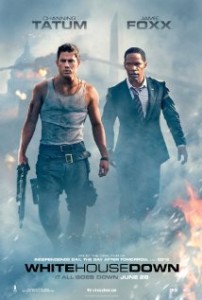
Early sequences point to a veritable armoury of ‘guns on the wall’ (not literal in this case, although there’s no shortage of noisy weaponry in the film!) that will eventually be wielded. During a tour of the White House in which the central character John Cale (Channing Tatum) is accompanied by his daughter, we are given various details about the location that subsequently come into play (for example, the fact that there are tennis and basketball courts and a swimming pool, all of which feature in a car chase during the thick of the action – a first maybe, in having such an action movie staple occur within the White House grounds).
Another seemingly minor detail is reactivated in similar manner, the substance of which marks a point of similarity with the Coen brothers’ film, although the handling is characteristically different. Cale has recently missed a talent show performance by his precocious 11-year-old daughter – a child who, like that of Llewyn, lives with the mother from which he has become estranged. This is a marker of his failure to act properly as a father figure, like Llewyn, but in this kind of treatment such a failure exists primarily in order to be righted. The performance, we are told, involved a display of flag twirling, something not accorded very high status in the narrative. But it is exactly such a routine that is situated as finally helping to save the day in the film, the daughter enacting a similar performance with the presidential standard in order to prevent a climactic levelling of the premises by the air force. In terms of plausibility, this is extremely silly, but the point is that it ‘makes sense’ in that broader way of knitting together a certain kind of self-sufficient narrative fabric. This isn’t even to mention the very obviousness of the fact that Cale, initially refused his dream job in the secret service, is clearly going to demonstrate through the film qualities that will result unquestionably in such an appointment, at the same time creating a unbreakably solid bond with his daughter. That the not taking of the road to Akron in Llweyn Davis signifies a complete refusal to enter into sentimental territory of this kind – even if the outcome might not have been expected to be a positive one – is a marker of just how different such films are in some of their central dynamics.
White House Down, then, solidly fulfils every initial narrative expectation (with room for the odd twist, here the fact that the seemingly most likeable of the other political figures in the diegesis turns out to be one of the bad guys). Llewyn Davis refuses to. Or does it, really? It depends what our expectations are, in such a case. In indie territory, and/or in that of the Coens, we might be encouraged exactly to expect such departures. These still remain matters of degree, however, and Llewyn Davis seems to go further that many indie equivalents in its determination never to accentuate the positive or to pick up or fire the gun. The effect that results remains dependent to a large extent on our sheer familiarity with classical convention, one that long predates its employment in Hollywood.


